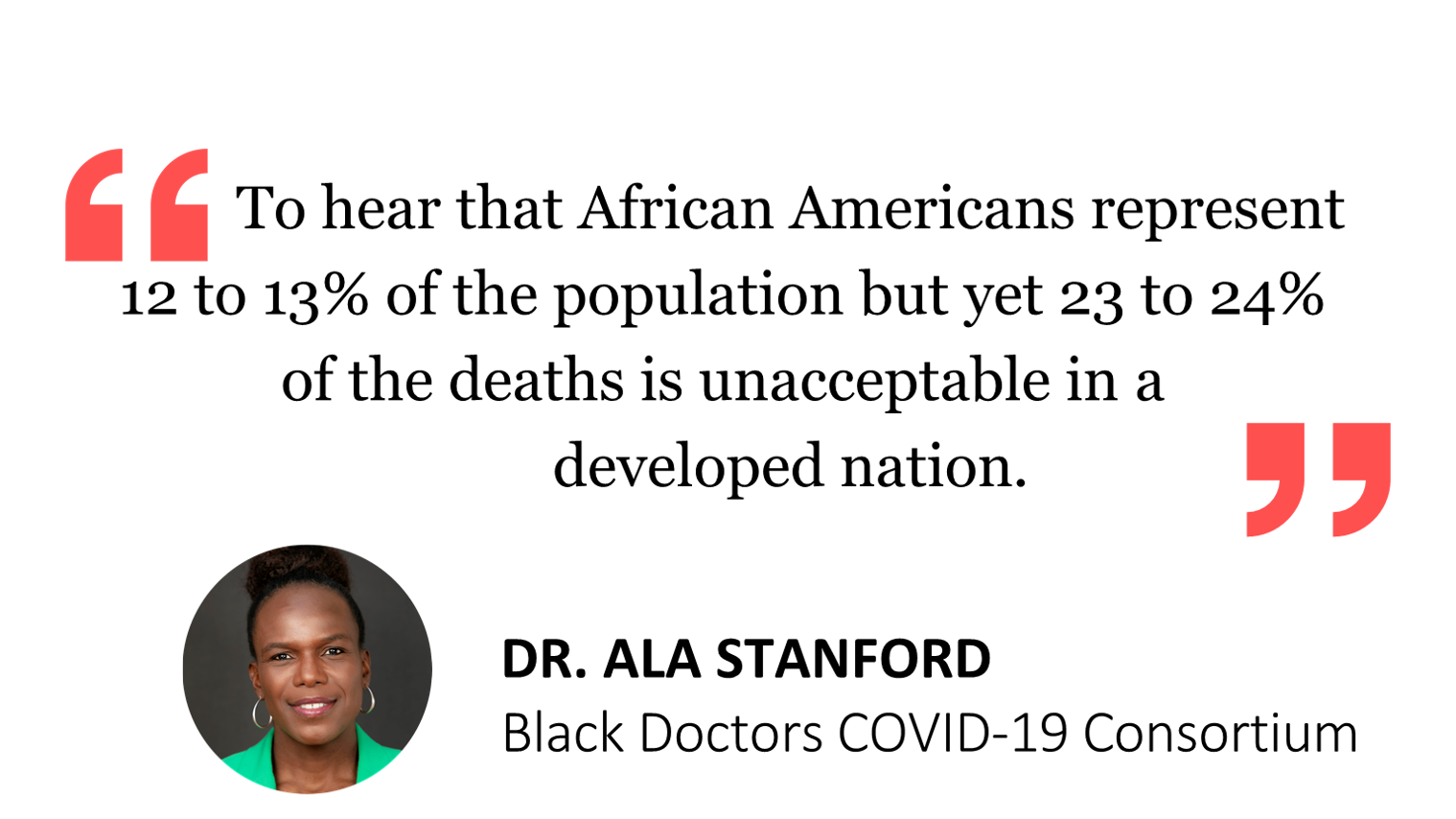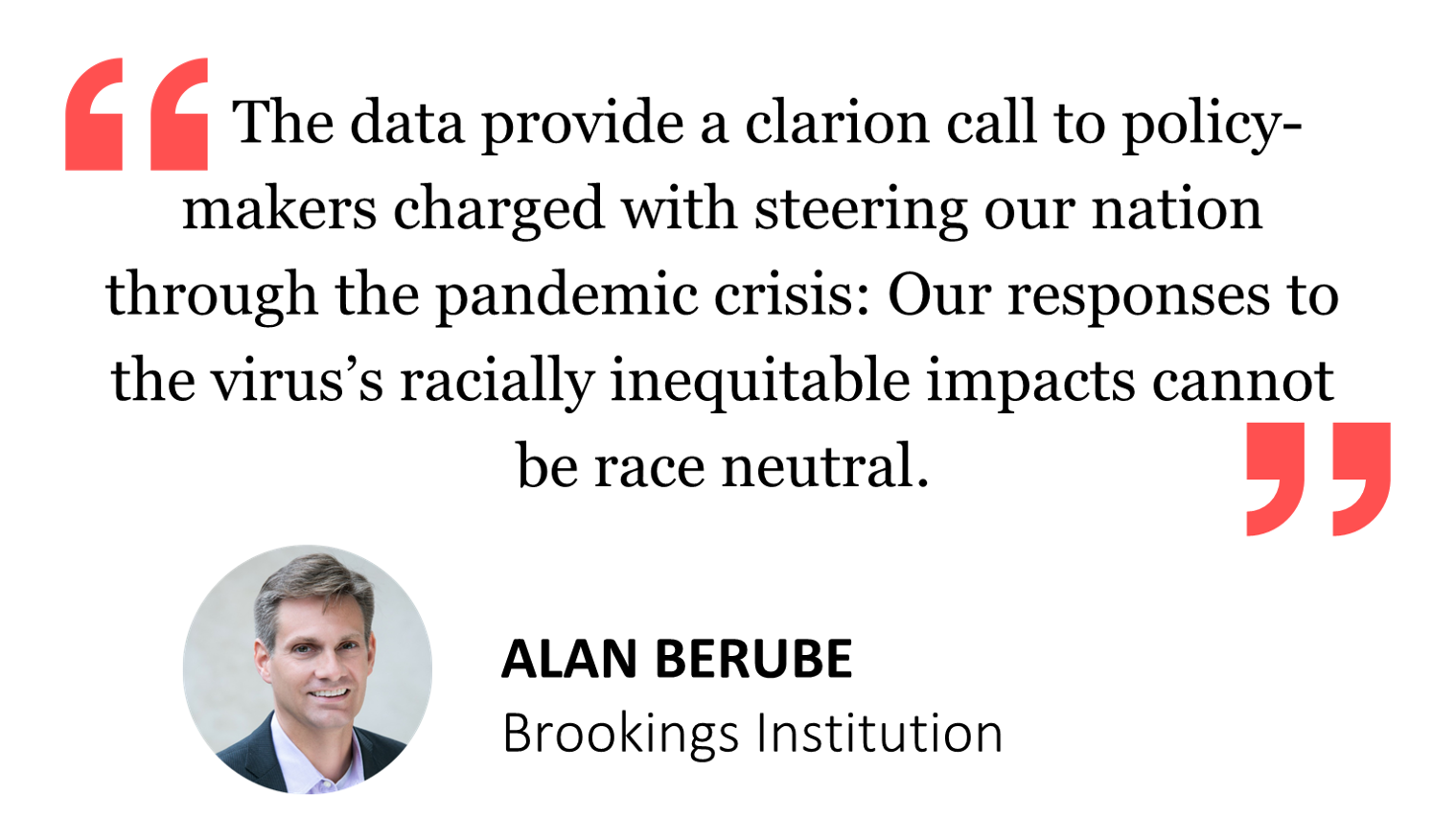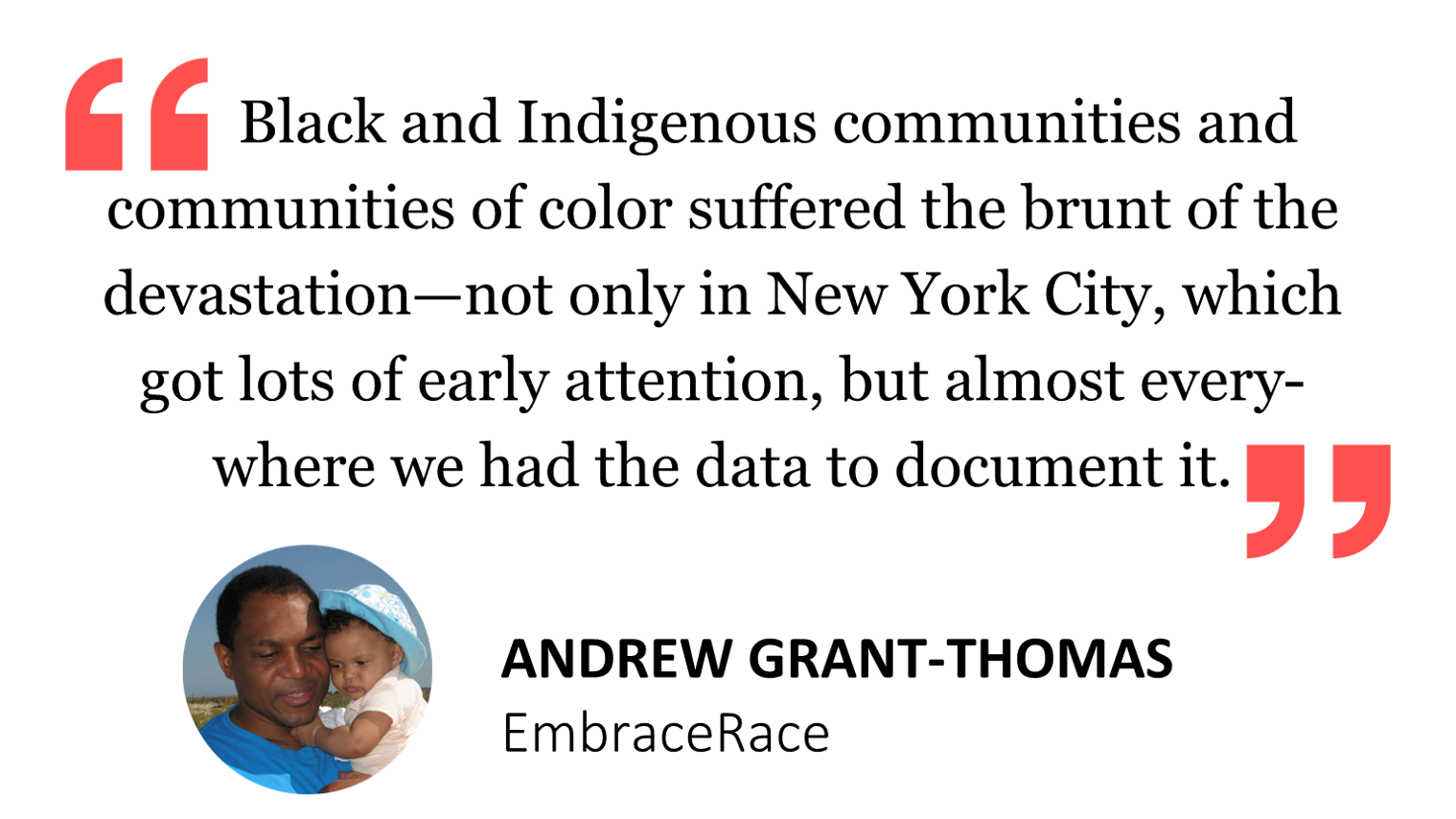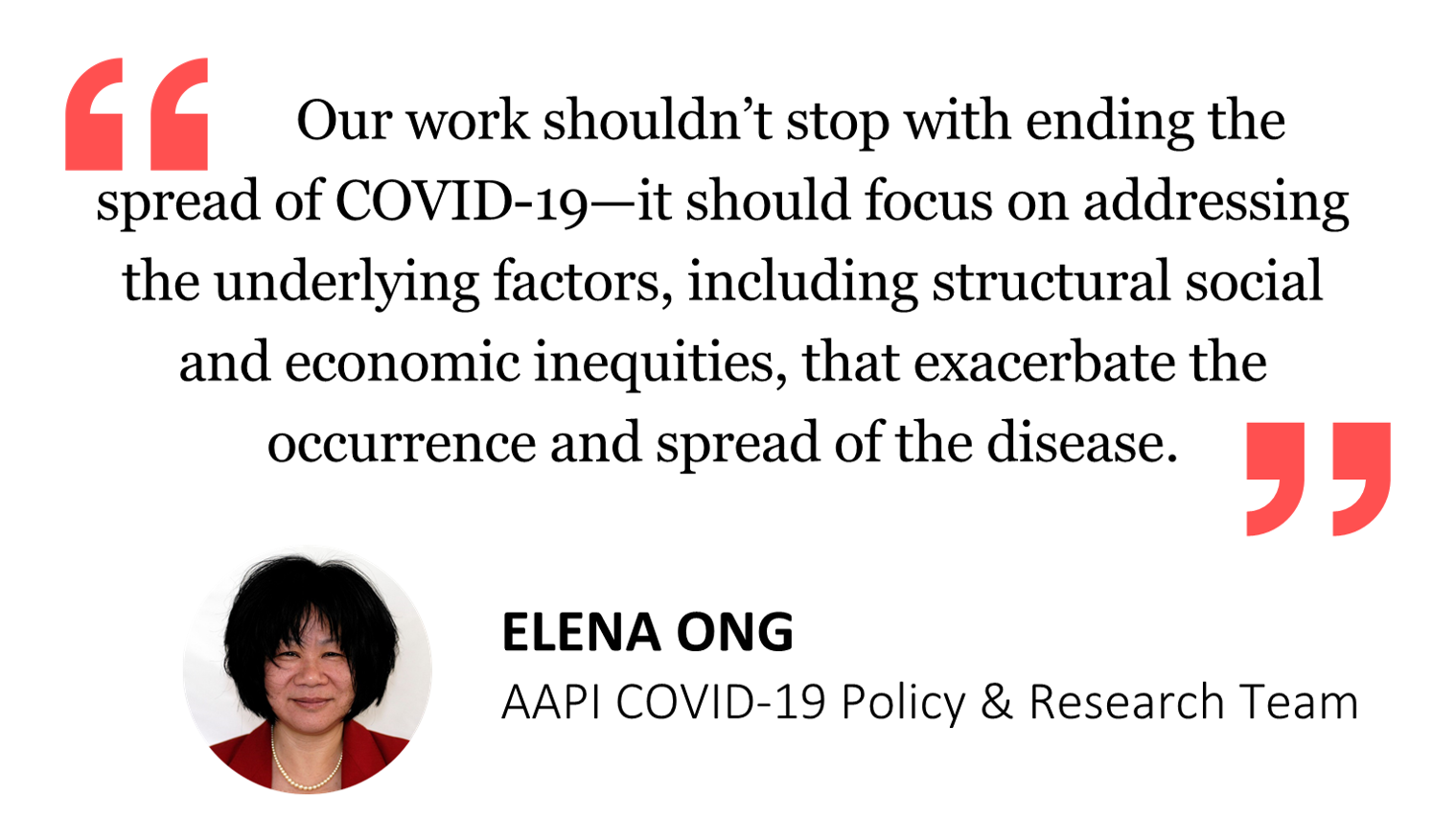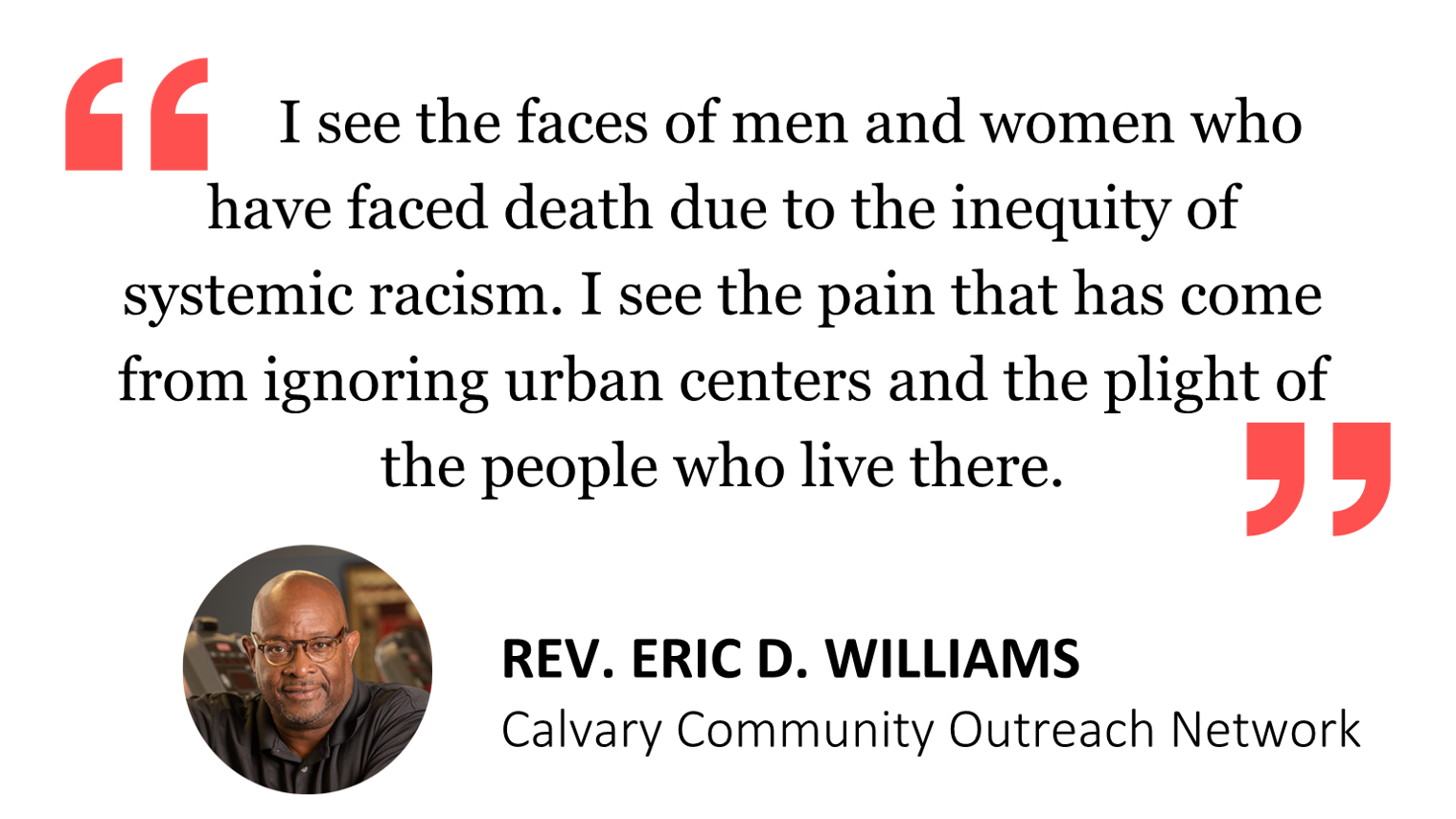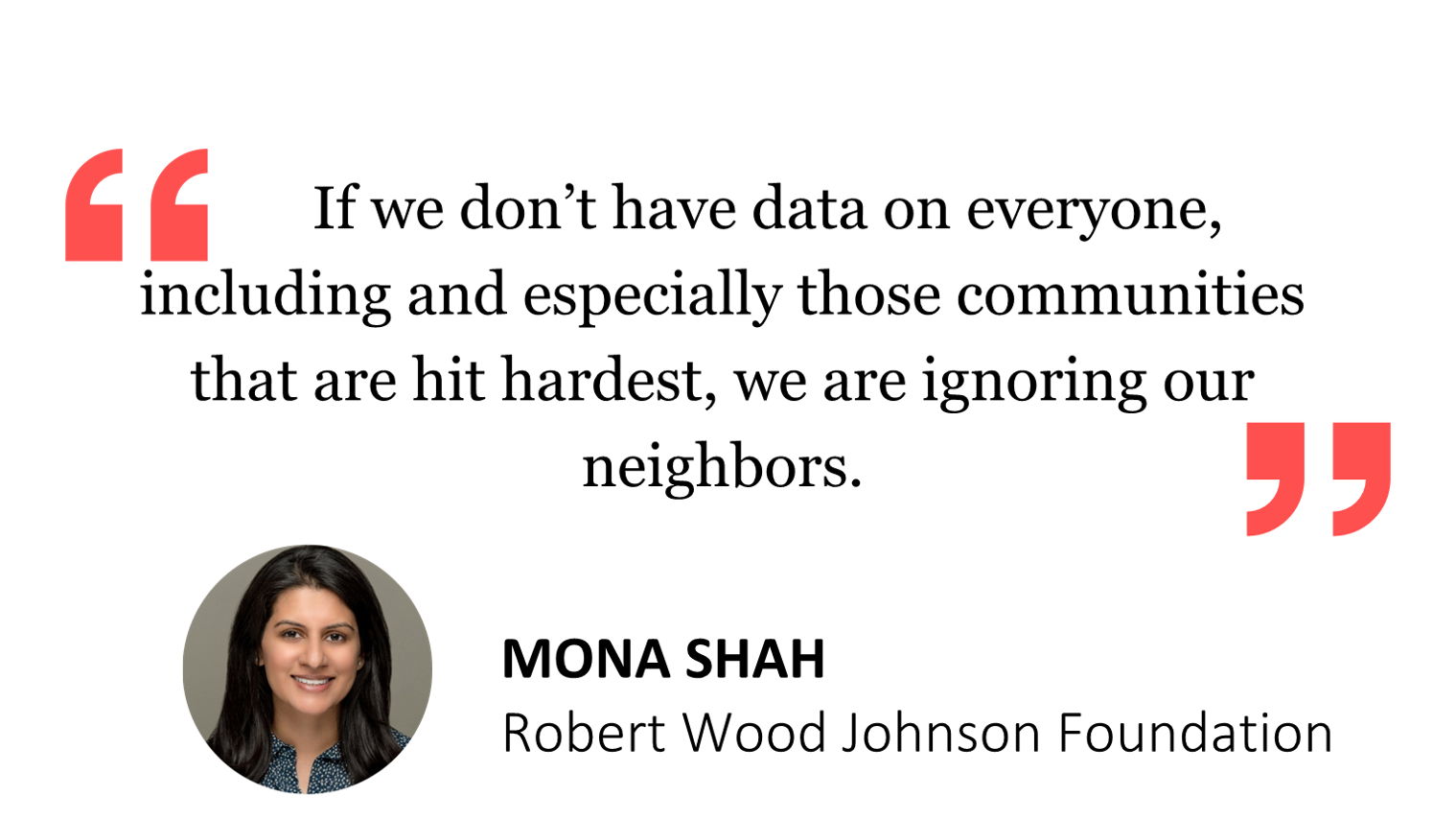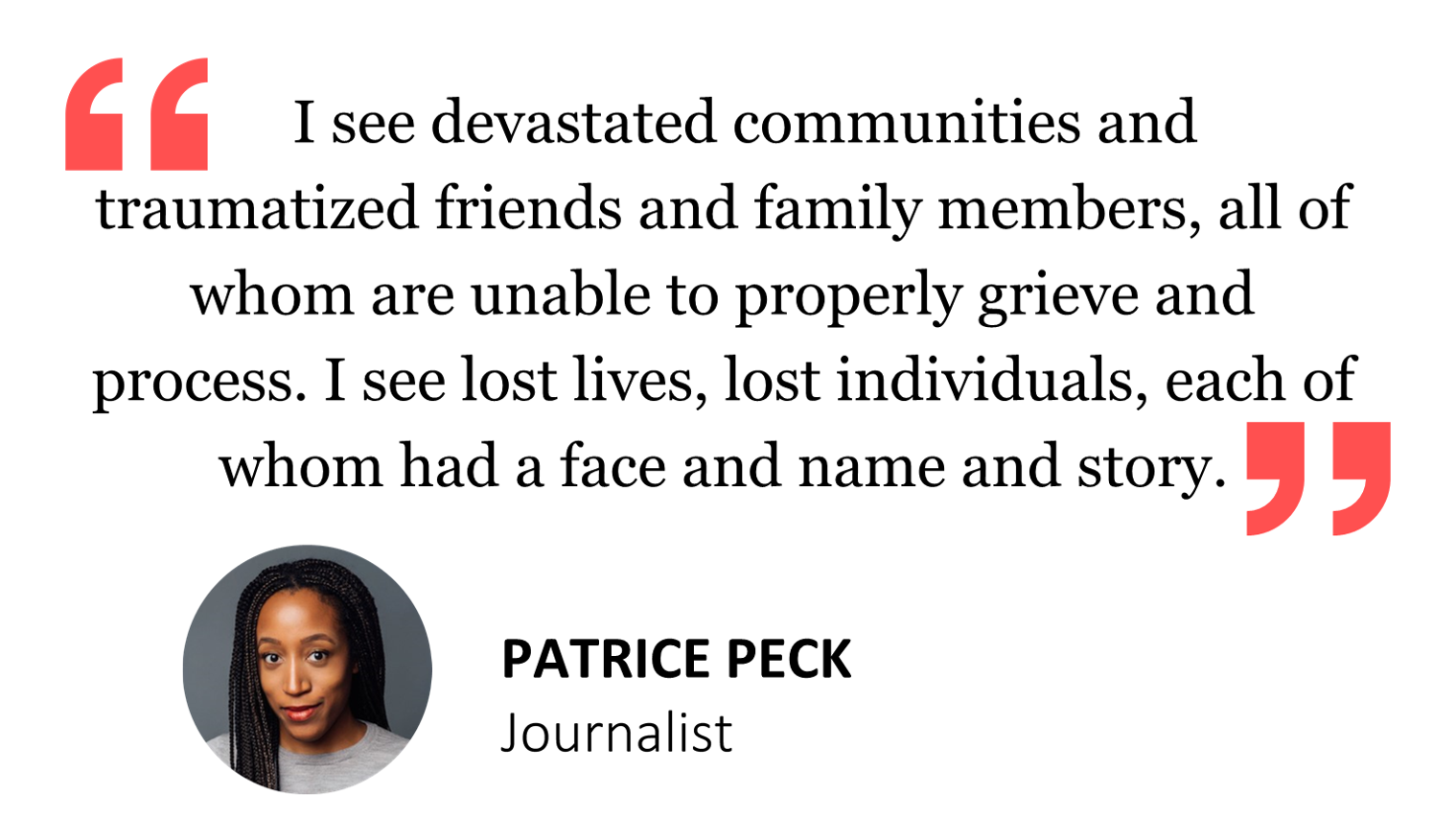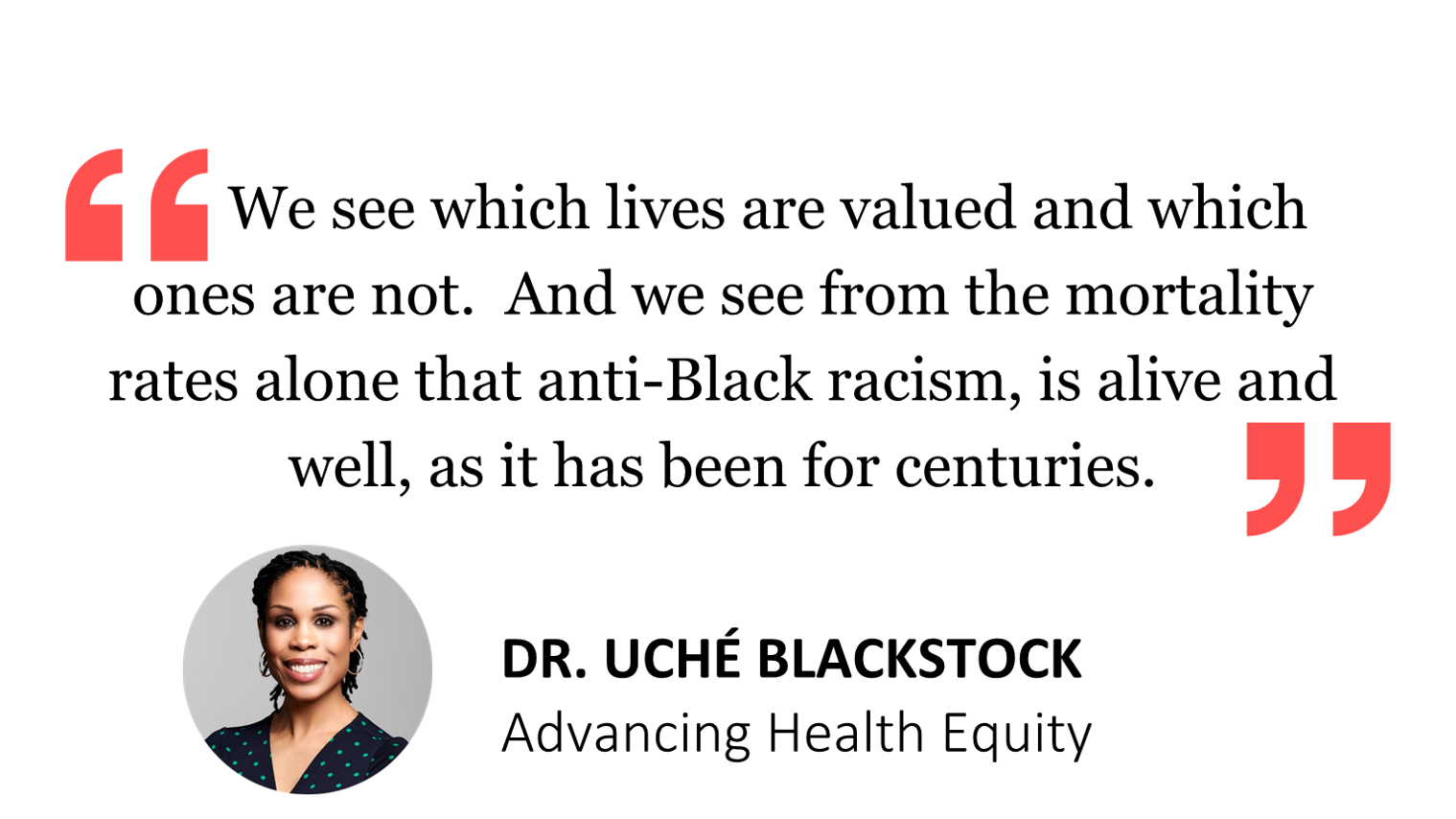THE COLOR OF CORONAVIRUS
RESPONSE Panel
Editor’s note: Since early April 2020, the APM Research Lab has been independently compiling, analyzing and reporting COVID-19 deaths by race and ethnicity, from all states publicly releasing data, and trumpeting the widely disproportionate toll of the virus in our Color of Coronavirus project. (The CDC did not then, and does not now, report deaths with the timeliness nor comprehensiveness of our effort.)
At the outset of our work, just over 5,000 American deaths from coronavirus had been reported. As of Aug. 4, the official death toll had exceeded 155,000, with Black, Indigenous, Pacific Islander and Latino Americans experiencing mortality rates of roughly triple or more that of White Americans, after adjusting for age.
The losses are immense. The disparities are undeniable. Families are grieving. Communities have been forever altered. And still the virus’ impacts continue. How do we begin to make sense of it all?
We’ve asked 10 thought-leaders from across the country to serve as an online “Response Panel” to help us reflect. Each was asked to reply to two questions:
What do you SEE in the data we’ve compiled? and
What do you think should be DONE about the data?
Their responses are wise and wistful, stirring and searing. They help us think about how this virus has changed us already and what additional changes may be required of us. We hope you appreciate their insights as much as we did. Please send us your reactions as well at info@apmresearchlab.org.
- ANDI EGBERT
Responses below are the opinions of the authors. Appearing here does not imply endorsement by the APM Research Lab. Responses have been lighted edited for clarity and length.
Click one of the profiles below to jump to that person’s response.
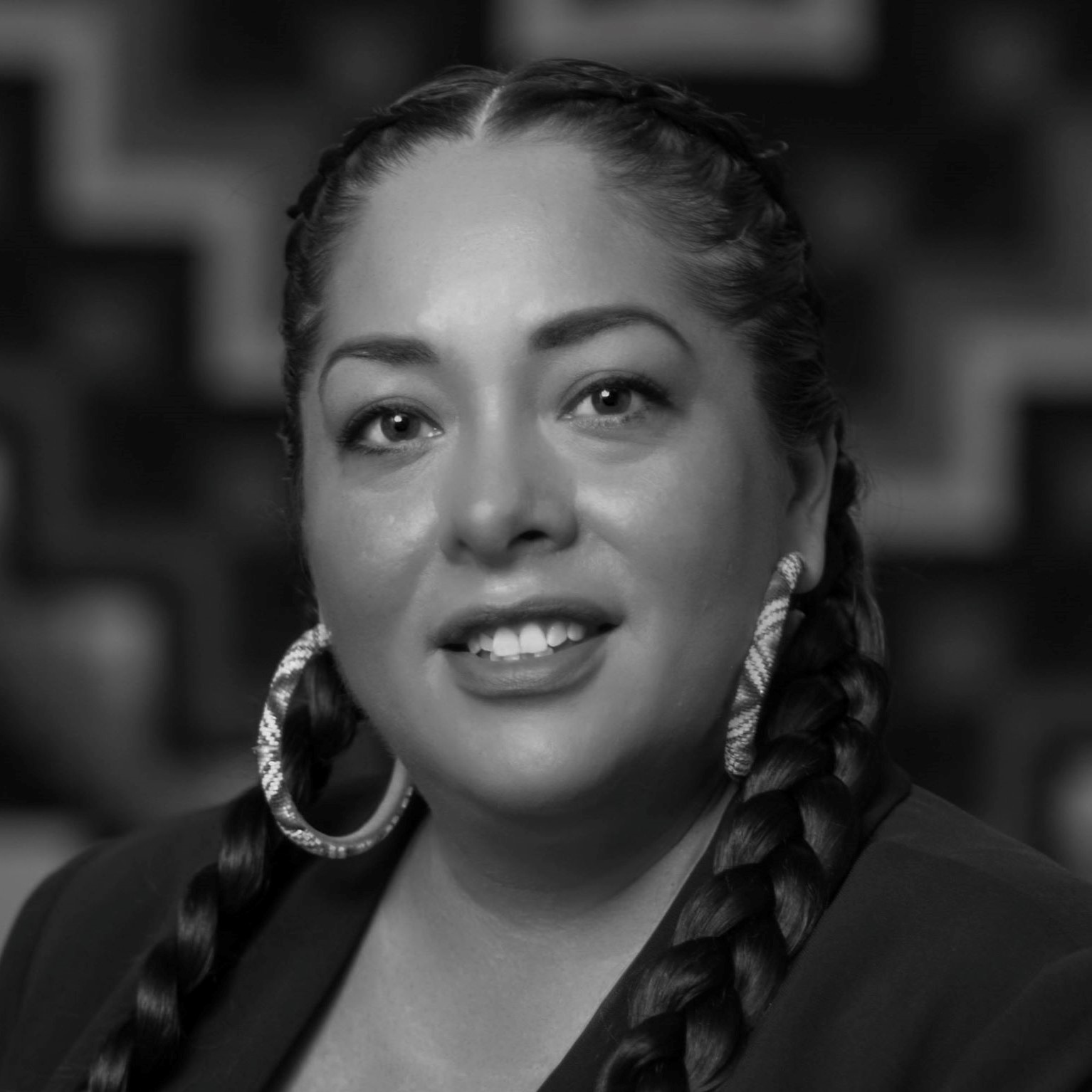
Abigail Echo-Hawk
(Pawnee Nation of Oklahoma)
Senior research officer at the Seattle Indian Health Board and director of the Urban Indian Health Institute
In this data I see an incomplete story. One that does not reflect all the beloved community members lost to this virus as a result of data systems that are actively working to make us invisible. This is highlighted in the presented data when it is noted that Indigenous people are often categorized into the “Other” category and thus not represented in the data. This junk data category tells us nothing, why is it still included in standard data collection nationwide? The answer lies in the institutional and structural racism embedded in data systems that render Indigenous people invisible in the data, a current day act of genocide.
In addition, with rampant racial misclassification and not counting multi-race Indigenous people in mortality data, more of our loved ones vanish from the data. They are born Indigenous and die classified as White.
Yet despite the gross undercount of Indigenous people in this data, audiences may be seeing parts of our stories represented for the first time. A story of unfulfilled treaty rights, economic suppression, and continued oppression within western systems that has directly contributed to the increased vulnerability of Indigenous people dying of COVID-19. However, we are not more at risk because we are Indigenous, we are more at risk because we live in a country whose ongoing practices and policies are killing us.
Now is the time to be boldly restorative and address race-based COVID-19 disparities by breaking down the ongoing systems of oppressions that are killing Indigenous people and other people of color. My organization, the Urban Indian Health Institute, is providing the tools and expertise to do this within data systems. We have published best practices in Indigenous data collection and analysis that can be used to inform policy and be implemented at the local, state and federal level. Yet, we know that political will is necessary to mandate and implement these changes. Policy makers often recite the rhetoric of “data driven decision making,” but how can they do that with bad data? This data highlights the need and opportunity for policies that mandate collection of race and ethnicity from a race and social justice perspective. Only then can “data driven decision making” become a reality.
This pandemic has highlighted the stark disparities in the health outcomes for people of color. This mortality data is the story of lives lost, and from an Indigenous perspective, as viewers of the data we now have a responsibility to that story. This responsibility includes ensuring the story is one that is truly representative by mandating proper collection of race and ethnicity data and to use the data to demand justice for people of color disproportionately impacted. No longer can this country turn a blind eye to the injustices perpetuated against Indigenous people, now is the time to stand in solidarity with us and demand change. Data for Indigenous people, by Indigenous people.
Editor’s note: At the time of this writing, 20 states did not independently report Indigenous deaths but have classified them as “Other” in their COVID-19 public reporting.
BACK TO TOP▲
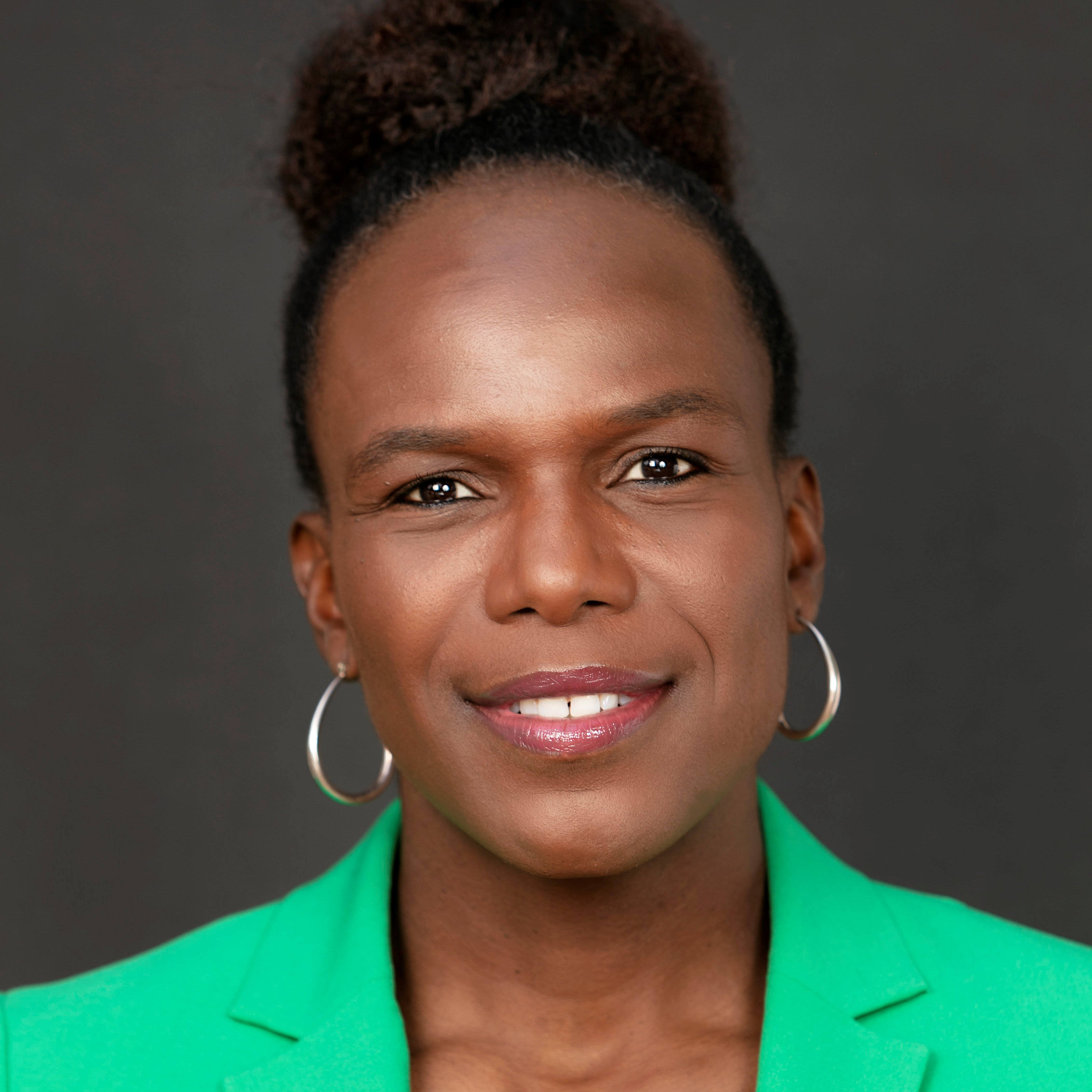
Dr. Ala Stanford
Pediatric surgeon and founder of the Black Doctors COVID-19 Consortium, a barrier-free, mobile COVID-19 testing operation serving the hardest-hit areas in Philadelphia and its surrounding communities
The data presented by APM is sobering. What I see each day in the community is substantiated in this body of work: hearing the barriers people face getting a COVID19 test and or attempts to be treated; listening to people speak about their loved ones dying after having prolonged symptoms unattended; people who share stories of many in a home being ill and trying to isolate and quarantine in tight, small spaces; elderly people without a referral from a doctor being turned away for testing.
The inescapable fact that I read repeatedly, undeniably and consistently is that African Americans are dying at a rate faster than any other group in America. To hear that African Americans, represent 12 to 13% of the population but yet 23 to 24% of the deaths is unacceptable in a developed nation.
Additionally, when I speak, and I advocate primarily for African Americans I receive backlash that other groups are equally important in this situation. The emphasis and resources must be placed on the most affected group. As a physician, I first do no harm. More initiatives and focus must be placed on an American group of people that are dying 80 deaths per 100,000 versus 36 deaths per 100,000 for Whites [reflects Lab findings through Aug. 4]. Also, African Americans are being lost in their youth—in their prime, at the most productive time of their lives at a rate two times greater than Whites.
It was disheartening to learn in my age group that I am six times more likely to die than someone who is 10 years older than me and White. It doesn’t matter that I’m a doctor or educated or that I have good insurance. This is not about income; this is about color. The virus does not discriminate; however, the people in the institutions that control whether you are tested, what resources are allocated to you, and how and if you are treated for coronavirus may discriminate—and it has the same deleterious effects on the African-American community. To not address this aggressively as health care professionals is doing harm.
I would like to see more emphasis placed on real-time efforts involving medical institutions, academic entities, federally funded centers and city health clinics. Efforts to collectively work towards reducing the deaths of African Americans at this alarming rate. Starting with more barrier-free testing, culturally competent contact tracing and safe and clean quarantine sites. Within hospitals, space must be provided for medical professionals to acknowledge and take action against their implicit bias, so we can have better health outcomes, treatment and experiences of African Americans within the health care system. The history of medical maltreatment and negative experiences cannot be discounted. It must be confronted with transparent discussions before we enter in with the proposition of vaccines in the Black community.
Learn more about Ala’s work at the Black Doctors COVID-19 Consortium.
BACK TO TOP▲

Alan Berube
Senior fellow and deputy director of the Metropolitan Policy Program at the Brookings Institution
APM Research Lab’s data on the Color of Coronavirus cuts through a dizzying array of statistics on the pandemic to reveal an essential truth: Racial inequality is a life-and-death matter in America. By bringing together valuable data from around the country, the project plainly shows that Black and Indigenous populations face much higher rates of COVID-19 mortality than other groups, forcing readers to consider how centuries of injustice in housing, health, and employment have placed these communities squarely along the virus’s destructive path.
The data provide a clarion call to policymakers charged with steering our nation through the pandemic crisis: our responses to the virus’s racially inequitable impacts cannot be race-neutral. Public health measures including testing, provision of PPE and other workplace safety measures, and eventual vaccination must go further to address the pressing needs of communities of color. Educational measures to sustain learning amid the pandemic must provide the extra technological supports that Black, brown, and Indigenous students too often lack. And economic measures must ensure that minority-owned businesses gain access to grants, loans, and technical assistance they have too often been denied by traditional programs.
Learn more about Alan’s work at the Metropolitan Policy Program.
BACK TO TOP▲
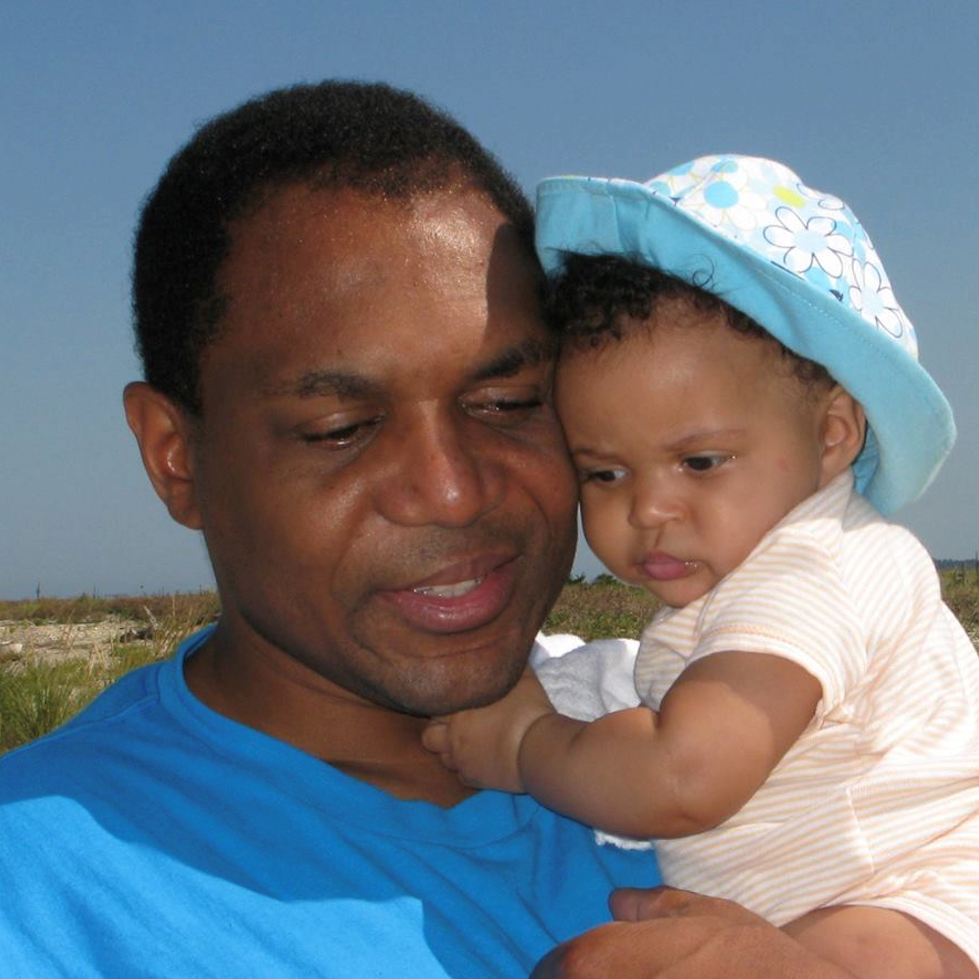
Andrew Grant-Thomas
Co-founder of EmbraceRace, a multiracial community of parents, teachers, experts, and other caring adults who support each other to meet the challenges that race poses to our children, families, and communities.
With the onset of the COVID-19 crisis in the United States we often heard that “we are all in this together.” Data compiled by the Color of Coronavirus Project told a somewhat different story, one in which Black and Indigenous communities and other people of color (BIPOC) suffered the brunt of the devastation—not only in New York City, which got lots of early attention, but almost everywhere once we had the data to document it.
At EmbraceRace, we also saw in the Project’s work a timely clarion call for much more racial and ethnic data-gathering and transparency. BIPOC, immigrant, and other racialized communities have sounded the alarm for a long time about the social, economic and political vulnerabilities imposed on us. We have long called for more data to sharpen our understanding of those vulnerabilities and better guide the search for remedies. The APM Research Lab’s data and observations have helped us take advantage of the opportunity COVID-19 presents to bring those concerns to an unprecedentedly large, national audience of researchers, elected officials and civil servants, philanthropists, and community members.
For EmbraceRace, raising awareness is a first step. Our regularly updated COVID-19: In Color, By the Numbers document, which includes Color of Coronavirus data, is available on our website, shared throughout our network, and has been picked up by organizations that include the National Center for Family Philanthropy, Harvard Library, and The Root Social Justice Center. Community members exposed to the numbers through these documents, related webinars, or otherwise have found them “eye-opening.” One professor said that COVID-19: In Color, By the Numbers provoked an excellent discussion in her classroom, and we’re confident her experience is far from unique.
The data and trends highlighted by the Color of Coronavirus project have also encouraged a broader conversation about why this pattern of racialized vulnerability is so painfully familiar, what we might do to disrupt it, and how we can participate in the work of creating a society in which we truly are all in this together. If the murder of George Floyd in Minneapolis marked a before-and-after moment in our country’s willingness to take meaningful strides on issues of racial justice and equity, it’s in part because painstaking efforts like those of the Color of Coronavirus project to document the racial contours of COVD-19 conditioned the ground on which Floyd's death and the protests landed.
BACK TO TOP▲
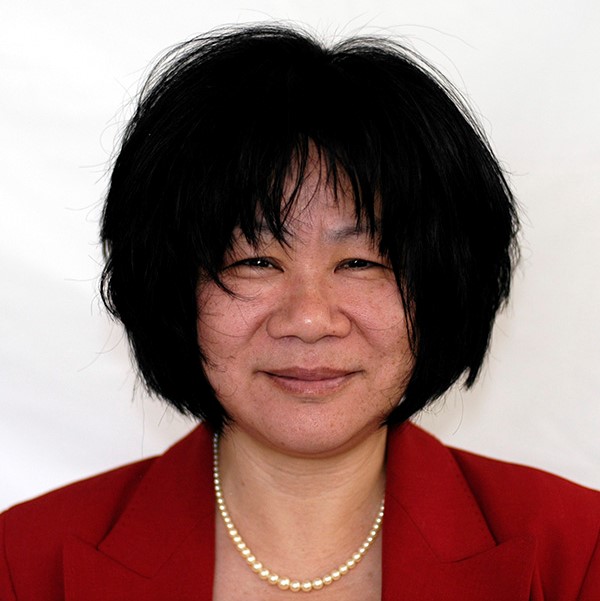
Elena Ong
Co-lead for the Native Hawaiian and other Pacific Islander COVID-19 Resource Team and manager for Asian American and Pacific Islander COVID-19 Policy and Research Team
The APM Research Lab's Color of Coronavirus places a magnifying glass on a widening divide between Whites and communities of color. Our work shouldn't stop with ending the spread of COVID-19—it should focus on addressing underlying factors, including structural social and economic inequities, that exacerbate the spread of the disease.
I am grateful to APM Research Lab for democratizing data collection and analysis of COVID-19 mortality statistics in a visually compelling way, at a time when it is mission- and vision-critical. It is not acceptable that “if communities of color died of COVID-19 at the same actual rate as Whites, about 17,000 Black, 3,000 Latinos, 500 Indigenous, and 50 Pacific Islander Americans would still be alive," as the APM Research Lab has documented.
These are extraordinary times, and there is a relationship between saving lives and livelihoods. We must all step-up if we want to safely re-open our economies. That’s why we need greater transparency in the collection and reporting of COVID-19 data by race, ethnicity, language, location, and occupation. That’s why we need to get providers, labs, and counties, to use [all racial and ethnic categories] and collect and report data in a culturally- and linguistically-sensitive manner. That’s why we need to get localities and states that have not made their race and ethnicity data publicly available to do so.
It is not acceptable that some states continue to aggregate the Asian and Pacific Islander COVID-19 statistics in an “Asian & Pacific Islander” category [presently Arizona, Connecticut, Delaware, Idaho, Michigan, New Mexico, Oklahoma and Wisconsin] or an “Other” category [presently Florida, Missouri, Rhode Island and South Carolina], as the Lab has helpfully noted. Doing so obfuscates the information needed to design and implement pro-active strategies that require an in-culture and in-language approach.
The Color of Coronavirus data has informed the community engagement and communications work of the National Pacific Islander COVID-19 Response Team, which has held press conferences and town halls on Pacific Islanders and COVID-19. News coverage about this response team has ranged from scientific journals, public health blogs, local print media, and ABC & CBS TV news. (See here and here.)
I also presented APM Research Lab data at a Health Equity presentation I gave at a Satcher Health Leadership Institute Initiative addressing the disproportionate impact of the COVID-19 pandemic on racial and ethnic minorities and other vulnerable populations. We use COVID-related data to inform policy makers. For example, the Asian & Pacific Islander COVID-19 Policy & Research Team, the NHPI COVID-19 Resource Team and the National Pacific Islander COVID-19 Response Team are working with the California Asian Pacific Islander Legislative Caucus to improve data collection and reporting within California, by disaggregating the data by Asian and Pacific Islander ethnic and language groups. Asian Americans may also have a higher death-to-care ratio, something that is exacerbated by xenophobia and the rise of hate.
We must address the three R’s: rescue, recovery and re-imagination. For at the end of the day, I'm concerned about COVID-19’s impact on health and economic well-being that will affect the color of equity, now and in the future. I’m concerned about CARES Act funding reaching communities that have the greatest needs. I’m also concerned about COVID-19’s impact on Census 2020 response rates, which could affect resource allocation and re-apportionment in the decade to come.
Elena Ong, PHN, MS, is an American Public Health Association (APHA) member who served on APHA’s Executive Board. She’s co-lead for the Native Hawaiian Pacific Islander COVID-19 Resource Team and manager for the Asian American & Pacific Islander COVID-19 Policy & Research Team.
BACK TO TOP▲

Rev. Eric D. Williams
Pastor at Calvary Temple Baptist Church and executive director of Calvary Community Outreach Network in Kansas City, Mo.
Thank you for your insightful compilation and assessment of the data around COVID-19 and race. It verifies what community organizers, activists and clergy have been shouting from the rooftops for decades.
Presented in a dialect that researchers, clinicians and foundation leaders trust, the data illuminates the inequalities that African Americans have silently lived with and died from.
In the data, I see the faces of men and women who have faced death due to the inequity of systemic racism. I see the pain that has come from ignoring urban centers and the plight of the people who live there.
They have succumbed to death and chronic disease at ages far earlier than their White counterparts. I hear the cries of loving family members who sit at hospital bedsides or attend funerals. They wanted their loved ones to experience a better quality of life. They hoped for more time to live and love.
It is my prayer that you will continue to publish this information. Your presentation of the data is like the light that appeared in a midnight Bethlehem sky over 2,000 years ago. It illuminated the countryside and the plight of the essential workers that lived there. The light enabled the world find direction. It showed them the course of action to take. It gave them hope.
Learn more about Eric’s work at Calvary Temple Baptist Church.
Listen to Eric describe outreach efforts by his church and other community members in Kansas City, Mo., in this interview on KCUR.
BACK TO TOP▲
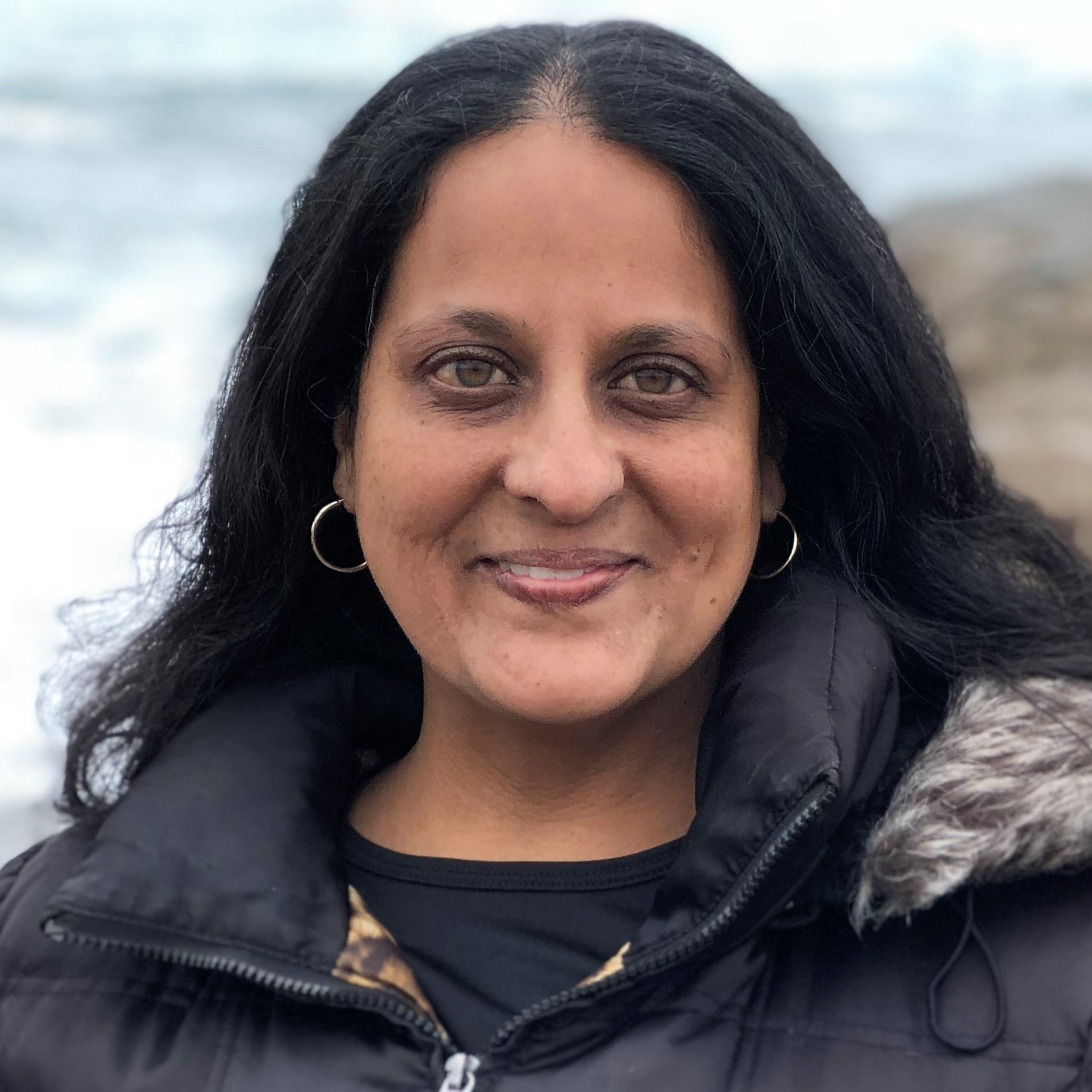
Kala Mehta
Associate professor of epidemiology and biostatistics at the University of California, San Francisco, and director of the NIH-BUILD Research Collaboratory
In the Color of Coronavirus data, I see clear race and ethnic disparities in COVID-19 deaths. African American, Indigenous and Pacific Islanders have disproportionately high risk of death due to COVID-19 compared to White communities, after taking into account age. It is important to understand that race/ethnic disparities are not new. COVID-19 is an acute pandemic which displays the importance of paying attention to ongoing race/ethnic disparities in infectious disease and in health in general.
We have developed the NIH-BUILD Research Collaboratory. This is an organization that brings together diverse faculty and students from around the country to address the topic of COVID-19 and race/ethnic disparities. Our goals are to use research on public datasets like the Color of Coronavirus data to develop community public health messages to address the community information divide. I'd like to see a strong, national response to COVID-19 disparities. We must stop the differential impact of this global pandemic on our communities.
Editor’s note: The APM Research Lab staff presented to students and faculty in the BUILD Research Collaboratory in August to share our Color of Coronavirus findings and methods.
BACK TO TOP▲

Mona Shah
Senior program officer at the Robert Wood Johnson Foundation
Communities of color, tribal communities, and the poor in America face well-documented disparities in both access to health care and overall health. We need to measure what matters and what matters is measured. If we don’t have data on everyone, including and especially those communities that are hit hardest, we are ignoring our neighbors.
I applaud the Color of Coronavirus project for including clear and accessible data, disaggregated by race, ethnicity, geographic region, and other relevant factors, which will shine more light on the current disparities in the COVID-19 response, particularly among communities of color.
Learn more about Mona’s work at the Robert Wood Johnson Foundation.
BACK TO TOP▲

Patrice Peck
Journalist, editor, producer, and founder of ‘SpeakPatrice Presents: Coronavirus News for Black Folks’
I see systemic and institutional racism in this data. More specifically, I see a historic and continued institutional disregard at all levels—particularly the current White House administration—for the health and well-being of Black and brown people across America. I see devastated communities and traumatized friends and family members, all of whom are unable to properly grieve and process. I see lost lives, lost individuals, each of whom had a face and name and story.
As for what should be done about the data, strategic community organization and advocacy has always been a key factor in disenfranchised communities successfully challenging racial disparities. I say look to the larger Black Lives Matter uprising, which is working to dismantle various forms of racism and discrimination against Black communities, forms that reinforce the white supremacy that upholds and perpetuates these COVID-19 mortalities. Also pay special attention to local efforts, many of which can serve as blueprints, like the Roots Community Health Center in Oakland, the Black Doctors COVID-19 Consortium in Philly, and the Bread of Life Deliverance Church in Charlotte.
To put it simply, for those of us who come from these Black and brown communities, we are—and always have been—all we got. But not “all” in a hopeless sense of lacking, moreso in the empowering sense of acknowledging the strength and power in our numbers and community.
Learn more and subscribe to Patrice’s work at ‘SpeakPatrice Presents: Coronavirus News for Black Folks,' a newsletter sharing stories about the coronavirus pandemic as it directly relates to Black communities.
BACK TO TOP▲

Dr. Uché Blackstock
Physician and founder and CEO of Advancing Health Equity, an organization that engages with organizations around bias and racism in healthcare with the goal of mobilizing for health equity and eradicating racialized health inequities.
In this data, we see the profound degree to which systemic racism remains embedded in every facet of this society. We see which lives are valued and which ones are not. And we see from the mortality rates alone that anti-Black racism is alive and well, as it has been for centuries. We also see how those in power in this country, specifically White leaders, have failed to show humanity and compassion towards the most vulnerable communities and have essentially placed Black, Latinx and Indigenous communities at risk for being infected and dying from coronavirus.
What needs to be done mostly begins with centering the communities most disproportionately impacted, Black, Latinx and Indigenous communities. These changes must occur at a structural level in order to be effective and sustainable. We will need policy that will not only expand testing and contact tracing resources, personal protective equipment, sick leave and healthcare insurance protections to these communities, but also funding for schools, housing and jobs in both the short and long-term. Healthcare institutions must do their part to address racist organizational cultures that inevitably trickle down to the care provided to patients and community members.


